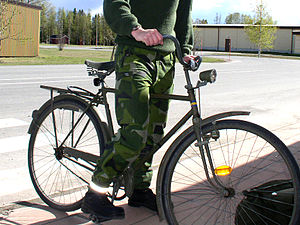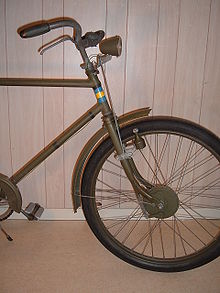- Swedish military bicycle
-
Swedish military bicycles (Swedish: militärcykel), or Swedish army bicycles, have been used in the Swedish military for over a century.
Contents
History
The first bicycles in the Swedish military were privately owned or bought for testing purposes. Bicycle infantry were first introduced in 1901, when a Gotlandic infantry regiment, I 27 in Visby, replaced its cavalry complement with bicycle-mounted troops. By 1942, there were six bicycle infantry regiments in the Swedish Army, operating mainly m/30s and m/42s. However, there were also examples of undesignated tandem bicycles for use by field radio operators and specially fitted pairs of bicycles designed for mounting a stretcher between the lead's rack and the rear's steer tube.[1]
Following World War II, in 1947, the decision was made to decommission the bicycle infantry regiments. They were gradually removed from the Army between 1948 and 1952. Following this decision, the role of the bicycle shifted away from a combat one to a more utilitarian one, with special bicycle transport groups being formed. However, bicycle rifle battalions (Swedish: cykelskyttebataljon) continued to exist into the late 1980s.[1]
Models
- m/1901 - A safety bicycle, it was the first officially designated bicycle in the Swedish army.[1]
- m/30 - A spoon brake-equipped, balloon-tired roadster. It was based around an agreement with several large Swedish manufacturers regarding the interchangeability of parts. Weight: ca. 23.5 kg (52 lb.)[1]
- m/finsk - A Nymans-manufactured bicycle without chainguard. The label finsk is the Swedish word for Finnish.[1]
- m/42 - The most well-known Swedish military bicycle. It was produced by several large Swedish bicycle manufacturers (Rex, Husqvarna, Monark, Nymans) from the 1940s to the 1950s with a maximum of interchangeable parts.[1] It uses a rear, one-speed Novo coaster brake hub and, on Husqvarna-produced examples, a front drum brake (chain-operated by an integrated right-hand lever). In addition, it has a large, sturdy rack with a tool box and storage tube for a short frame pump. Weight: up to 26 kg (57 lb.)
- m/104, m/104A[1]
- m/105, m/105A - 26 × 1½ inch (584 mm) wheels with Sachs Torpedo rear hub.[1]
- m/111 - Post-1971. 28 inch wheel with Sachs Torpedo rear hub.[1]
Civilian use
Further information: Kronan (bicycle)Beginning in the 1970s, the Army began to sell its m/42s as military surplus. They became very popular as cheap and low-maintenance transportation, especially among students. Responding to its popularity and finite supply, an entirely new company, Kronan, was founded in 1997 by three students in Uppsala in order to produce a modernized replica of the m/42. These come in a variety of colors, compared to the matte green and gray of the surplus models, and can even be purchased with three-speed SRAM hubs and front brakes.[2] Unlike the military surplus m/42s, these have been widely exported to other countries. Reports of quality control problems with some of the new bicycles emerged on the internet soon after they went on sale in the US.
See also
- Bicycle infantry
- Swiss army bicycle
References
- Stenqvist, Åke; van Helden, Ben (2004-04-09). "Hermes m/42" (in Dutch and English). Archived from the original on November 24, 2004. http://web.archive.org/web/20041121095909/http://www.benvanhelden.nl/Condorclub/Fiets/Sweden/hermes/Hermes.html. Retrieved July 26, 2006.
- (Swedish) Cykelhistoriska föreningen (April 2001). "Militärcyklar" (in Swedish). Velocipeden 17 (5): 6–13.
- Stenqvist, Åke. "A small history of Bicycles in SWEDEN". Archived from the original on March 25, 2005. http://web.archive.org/web/20050325153415/http://www.benvanhelden.nl/Condorclub/Fiets/Sweden/History+Army+Bikes+Zweden.html. Retrieved July 26, 2006.
External links
Categories:- Bicycle models
- Military vehicles of Sweden
- Cycle types
- History of cycling
Wikimedia Foundation. 2010.


